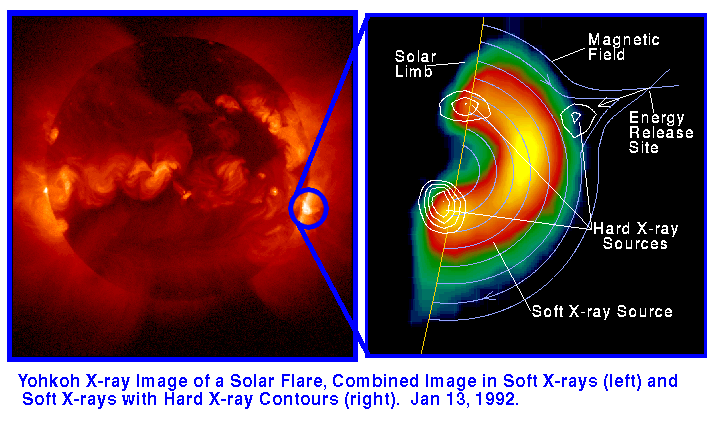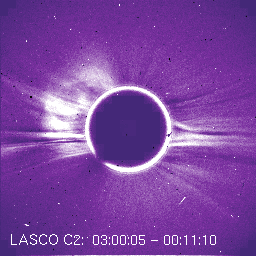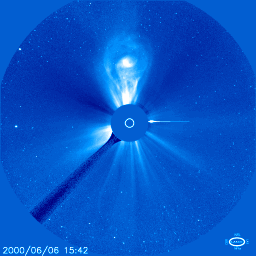Coronal Mass Ejections
What is a flare?
Solar flares are the biggest explosions in the solar system. We say that we've seen a solar flare when we see a huge and sudden increase in brightness on the Sun. The increase in brightness isn't just seen in visible light (in fact it often isn't!) but in lots of other parts of the electromagnetic spectrum as well - in X-rays, gamma-rays, UV and radio waves.Flares happen in active regions. These are parts of the Sun where the magnetic field is particularly strong and complicated and because of this there is a lot of magnetic energy associated with these regions. When the energy that has built up in the active region is released we see a flare.
This is what a flare looks like when we look at it in X-rays with the
Yohkoh satellite. The image of the whole Sun on the left is a soft X-ray
image taken with the Soft X-ray Telescope (SXT) on Yohkoh. We can see the
bright flare on the West limb of the Sun - East and West are swapped on
the Sun because we're looking at it rather than actually being on the Sun!
The image on the right is a close up of the flare loop that we see in soft
X-rays. The colours are showing us where the hottest parts are, so the
hottest bit is the bright yellow at the top of the loop. The blue lines
are a sketch of how we think the magnetic field lines look and where we
think the energy is being released. The white contours (circles) are telling
us that there is more energetic emission than the soft X-rays happening
as well-we call this hard X-ray emission. This particular image came from
the GSFC
solar flare theory pages
The first solar flare was seen in 1851 when Carrington and Hodgson were
independently monitoring sunspots. This one actually was seen in visible
light and they saw a sudden brightening. Of course this wasn't the first
flare the Sun had actually produced, just the first one that we'd ever
been able to see!
The other effect that flares have on us is that the UV radiation from
the flare can heat up the upper atmosphere making it expand. When this
happens there's an extra drag force on spacecraft which makes them lose
height. The spaceraft thrusters would then need to be fired to get it back
into the correct orbit. 
How much energy do they produce?
The amount of energy that's released in a typical flare is about the same
as 100 megaton bombs exploding all at once. That's about 10 million times
more than the energy released by a volcanic explosion! But compared to
the amount of total energy the Sun emits every second it's pretty small-
only about 1/10.
How long do they last?
Most flares are quite short really, less than hour. The longest flare that
we've seen with the Japanese Yohkoh satellite was 12 hours though. Compared
to flares on other stars though the Sun is a bit of a wimp - some of those
flares are a thousand times more energetic than the Sun and can last up
to 10 days!
How often do they happen?
The number of flares that we see is related to the Solar
Cycle. When we're near the peak of the 11 year cycle then there are
lots of active regions on the Sun and there are lots flares - multiple
ones a day around the maximum. When the Sun's quiet, near the minimum of
the cycle then there are much fewer flares. Sometimes there are periods
when there are no active regions at all visible.
How do they affect us?
The energy that's released by a flare heats up and accelerates charged
particles i.e. electrons, protons and nuclei. These energetic particles
produce the X-ray, gamma-ray and radio emission that we see during the
flare but some of them can also escape into interplanetary space where
they can affect astronauts and electronic instruments in space. For spacecraft
in low Earth orbit the Earth's magnetic field provides some protection,
as does the body of the spacecraft, but outside the protective influence
of the Earth's magnetic field the risks are much greater. Even in low Earth
orbit astronauts can still be exposed to large radiation doses though.
This is most likely in polar orbits becuase it's easiest for energetic
particles to penetrate the Earth's magnetosphere here. That's also why
we see the spectacular aurora borealis (northern lights) though so there
is a plus side!
What is a Coronal Mass Ejection?
Coronal mass ejections (CMEs) are huge bubbles of the solar atmosphere that are thrown out into interplanetary space. We see them by using instruments which occult the photosphere, in effect they are creating an artificial solar eclipse. When this is done the corona can be seen and the density variations of the corona are mapped out by radiation which is scattered off coronal electrons. The corona appears brighter where there is more coronal material along the observers line of sight. A time series of images shows the coronal mass ejection to be a moving bubble of bright material.The image on the left is taken with a coronagraph called C2 onboard the SOHO spacecraft and shows a bubble
of plasma ejection off the Sun's east limb. The movie on the right is taken
with C3 a coronagraph with a larger field of view and shows two
CMEs. The first is a bubble ejected form the north pole of the Sun and the second a 'halo'
CME which can bee seen surrounding the occulting disc and increasing in size as
it moves away from the Sun.
CMEs can happen anywhere on the Sun not just in active regions where the magnetic
field is concentrated. Their occurence is still thought to be linked to the
solar magnetic field though and it's long term evolution. The Sun's magnetic
field is generated via a dynamo action deep in the interior and the magnetic
field lines then rise and emerge through the photosphere. This magnetic flux,
which is constantly being injected into the solar atmosphere, needs to be
removed and CMEs are the process by which this happens.


How much energy do they produce?
The energy of of a CME is mostly kinetic, that is due to it's motion. The
amount is comparable to the energy released during a large flare.
How often do they happen?
The number of CMEs rises and falls with the solar cycle. About 1 CME
occurs every 3 days at solar minimum and up to about 3 CMEs a day at solar
maximum! They can be launched at any location on the Sun but during solar minimum
they are most commonly produced at the equator. As solar activity increases
they become more common at higher latitudes indicating the changing of the
large scale magnetic field with solar cycle.
How do they affect us?
CMEs carry a huge amount of solar plasma threaded with magnetic field lines and
can effect the Earth environment in a variety of ways. The events which are
Earth directed, and appear as halos of bright material around the Sun, are the
most likely to be detected at Earth. Luckily the Earth has a protective
magnetic field around it, like that of a bar magnet, which protects us from most of the
material the Sun throws at us. The magnetic field in the CMEs can have any
orientation but it is those with southward directed fields that effect Earth
the most. When this happens the magnetic field of the plasma and the Earth's
magnetic field are oppositely aligned and a process called reconnection can occur
allowing the solar plasma into the Earth's normally protective
environment. As the name reconnection implies the connectivity of the magnetic
field lines are changed and lines originally only connected to the Sun join
those that are connected to the Earth. For Earth effects of CMEs see the Why study the Sun section.